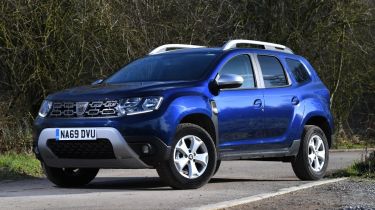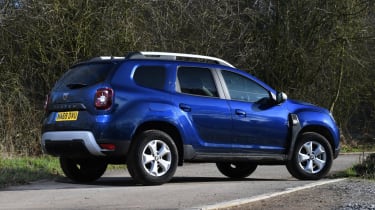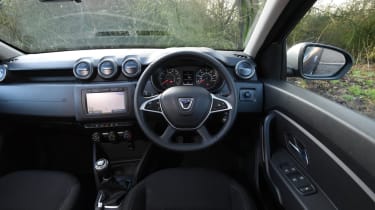Used Dacia Duster (Mk2, 2018-2024) buyer's guide: puts more expensive SUVs in the shade
Our full used buyer’s guide on the Dacia Duster, covering the Duster Mk2 that was on sale between 2018 and 2024
Verdict
The Dacia Duster isn’t as ‘shockingly affordable’ as it once was, but compared with its key rivals, it still represents impressive value and it remains easy to recommend. When we ran a Mk2 Duster Blue dCi 115 Comfort for nine months, we were surprised at how wide-ranging its talents were. We found the quality to be on a par with much more costly rivals, while its comfort levels were often superior, and its practicality was excellent. So it came as no surprise when we pitted a Duster against the MG ZS and the Nissan Qashqai in two separate tests, that the Dacia came out on top. The Duster Mk2 is a car that you can buy with your heart as well as your head.
When Romanian state-owned brand Dacia arrived in the UK in the early eighties, it hoped to sell 10,000 cars per year. But instead the marque retreated soon after, with few of its Denem saloons and estates finding buyers. The firm also imported the no-frills Duster off-roader, which again sold in tiny numbers before Dacia disappeared from these shores, seemingly forever.
By 1999, Dacia had become a subsidiary of Renault, but it wouldn’t be until 2013 that the Romanian brand returned to the UK with an all-new Duster. Since then Dacia has gone from strength to strength here, largely because its cars are so much cheaper to buy than virtually all its rivals.
History
The Duster Mk2 (Mk3 if you include the eighties cars) reached UK showrooms in July 2018, with a choice of 1.6-litre SCe 115 petrol or 1.5-litre Blue dCi diesel engines, both rated at 114bhp. Within weeks, two more petrol engines had joined the range: the 1.3-litre TCe 130 and TCe 150 with 128bhp and 148bhp respectively.
In August 2019 the 99bhp 1.0-litre three-cylinder TCe 100 superseded the SCe 115. A Bi-Fuel (petrol and LPG) version of the TCe 100 arrived in February 2020.
Used - available now

2021 Dacia
Duster
47,534 milesManualDiesel1.5L
Cash £9,287
2021 Dacia
Duster
24,942 milesManualPetrol1.0L
Cash £11,500
2022 Dacia
Duster
9,260 milesManualPetrol1.0L
Cash £13,592
2021 Dacia
Duster
11,920 milesManualPetrol1.3L
Cash £13,995An updated Duster was available from September 2021, with a refreshed front-end design, a redesigned dashboard with improved infotainment, and extra driver- assistance systems. A six-speed automatic transmission – dubbed EDC, for Efficient Dual Clutch – was also available for the first time, but this could only be specified with the TCe 150 petrol engine. It went off sale in 2024 when the Duster Mk3 arrived in the UK.
Which one should I buy?
We’d avoid the SCe 115, because its non-turbo engine provides leisurely performance, but any of the TCe engines will feel more perky. The TCe 130 is the sweet spot in terms of economy and performance, but don’t overlook the Blue dCi 115, which is frugal and offers decent pace.
The ultra-basic entry-level Access is incredibly rare and the only piece of ‘luxury’ kit that it features is electric front windows. Move up to the Essential spec and you get a radio, Bluetooth and air-con, while the Comfort has upgraded interior trim, a trip computer, cruise control, 16-inch alloys, privacy glass, powered rear windows, a seven-inch touchscreen with navigation, a rear parking camera, and heated electrically adjustable door mirrors. The Prestige adds climate control, 17-inch wheels, keyless entry and blind-spot detectors.
Alternatives to the Dacia Duster
The Dacia’s closest rival in terms of price and size is the MG ZS, which is also good value, but isn’t as sophisticated as most of its rivals. The Duster straddles two segments: mini-SUV and compact SUV. The former includes the Citroen C3 Aircross, Peugeot 2008, Nissan Juke, Renault Captur, Mazda CX-3 and SEAT Arona, along with the Kia Stonic, Hyundai Kona, Ford Puma and Vauxhall Crossland.
Move up a segment and you can pick between the Nissan Qashqai, Hyundai Tucson, Kia Sportage, SsangYong Tivoli and SEAT Ateca, as well as the Ford Kuga, Peugeot 3008, Skoda Karoq and Mazda CX-5. Most of these alternatives feel more sophisticated than the Dacia, but you’ll pay more for them, and they’re no more practical and not necessarily easier to own.
What to look for
Spare tyre
A full-size spare fits under the boot floor of all Dusters, apart from the Bi-Fuel. It was an extra-cost option across the range.
Safety
Poor Euro NCAP results don’t reflect structural weakness; a lack of tech such as lane-keep assist and some airbags means it can’t get five stars.
Warranty
The standard three-year/60,000-mile warranty can be extended cheaply, giving up to six years or 100,000 miles of cover.
Towing
The Duster Blue dCi 115 won a tow-car award in 2019. Initially, most Dusters were rated at 1,500kg, but in 2022 this was reduced to no more than 1,200kg.
Reliability
The Duster performed well in recent Driver Power surveys, and although Dacia came 27th out of 30 manufacturers in our latest brand poll, with 27 per cent of owners reporting first-year faults, we think most of the problems were with other models.
Interior
Entry-level Dusters are astonishingly basic, although mid-range models are far plusher and will be much easier to sell on. Buy at least a Duster Essential if you want such niceties as a 60:40 split-folding rear seat, plus height adjustment for the driver’s seat and steering wheel.
Some switchgear is oddly placed, but all Dusters have plenty of room for five adults, and boot space is generous, at 445/1,623 litres, although four-wheel-drive models cut this to 411/1,614 litres.
Prices
Of the 400 or so second-hand Mk2s that we found for sale, one in eight was a diesel. Autos are extremely rare; we found just 13 of them, while Dusters with four-wheel drive are even rarer.
Running costs
Dusters need to be serviced at 12 months or 18,000 miles, theoretically alternating between A (minor) and B (major). However, for those who cover high mileages, it’s recommended that the two services are combined.
The A service is just a cabin-filter change, whereas the B service includes engine oil and filter, plus checks of the car’s fluid levels and various systems. Priced separately, the A service costs £99 and the B is £179, but dealers will combine them for £199. As well as this, the brake fluid needs to be replaced every three years, at £98, and the coolant every five years or 90,000 miles, at £110. The majority of the Duster’s engines are chain-driven, however 1.5-litre diesel has a cam belt and will need to be changed after 90,000/six years at a cost of £799.
Recalls
Dacia has a pretty good record when it comes to recalls, because across its entire model range, the brand has issued only a dozen campaigns after its return to the UK a decade ago. Since the Duster Mk2 was launched in summer 2018, Dacia has issued six of these recalls, but only one of them was aimed at the Duster Mk2.
That campaign was launched in November 2020 and it affected just a few early Dusters built up to October 2018. It’s hard to say how many Dusters were recalled, because of the 2,611 vehicles included, there were also some examples of the Sandero and Logan.
The problem centred on the ignition switch on affected models, which might need to be replaced. This was because the car key might not disengage properly if it jammed in the start position.
Driver Power owner satisfaction
The Duster Mk2 made its Driver Power debut in the 2021 new-car survey in 16th place out of 75, and followed this with an even more impressive 14th in 2022. A top spot for value should come as no surprise, but fifth for the usability of the infotainment is unexpected. Other highlights include the running costs, safety features and ergonomics; owners don’t like the cabin quality, performance or seat comfort so much.
What do owners think?
Here’s what owners in the 2024 Driver Power survey thought of the Dacia Duster Mk2.
| What they like | What they don't like |
| “This is my second Duster. The amount of car you get for the money is fantastic. I just love her all over! | “I wish Dacia would offer a four-wheel-drive petrol, like they do in other markets. I don’t want a diesel!” |
| “Wherever I’m driving, on my own or with my family, the Duster is ideal. Quite an achievement for a £16k car!” | “The interior could feel a bit more upmarket, especially the floor mats, which move in the footwells.” |
| “Great audio quality. It’s not far off the Harman Kardon system in my Volvo S90, and that was an £800 option.” | “My biggest bugbear is the poor fuel economy, especially as acceleration isn’t all that great.” |
| “The Duster is a keenly priced SUV that’s spacious and good to drive. I’ll buy another one next year.” | “The front seats aren’t supportive on long journeys, and those in the back don’t have enough legroom.” |
| “Our Duster has been far more reliable than our previous VW Group cars, all of which were new.” | “The rear seats don’t fold to give a completely flat load bay, which is annoying if carrying large items.” |
| “For the price, cabin design and quality are both good, and thanks to the ample glass area and big mirrors, visibility is great. However, thick A-pillars are intrusive if emerging from junctions.” | |
| “The power steering is light and positive, which makes long drives and manoeuvres a breeze. The ride quality is better than the Sandero we had before, although on rough roads it can still be a bit crashy.” | |
| “There’s enough space for two adults, two children and a dog. There are plenty of cubbies in the cabin and the boot has never failed me – it has enough space no matter how much luggage we have, as long as the dog is on the back seat!” |










